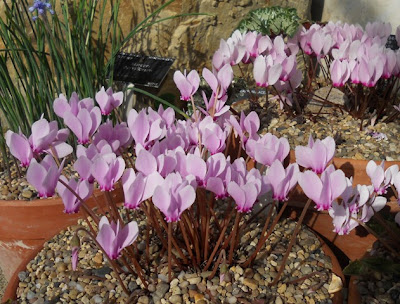It is reputed to be a good amorous medicine to make one in love, if it be inwardly taken
It is also poisonous, it being the tuber of the Cyclamen. Still, cooking turns it into a love potion according to John Gerard in 1597.
Many centuries earlier, the Greek doctor and naturalist Dioscorides was even more effusive about the medicinal powers of Cyclamen. Most famously these include making pregnant women abort if they walk over it (or speeding up their birth if they wear it) and 'purging the head' when absorbed through the nose.
Today we enjoy cyclamens as a pot or garden flower. At Kew Gardens and Wakehurst Place, September and October are cyclamen months. Just as everything else is fading, cyclamens (along with Colchicum autumnale, the so-called Autumn Crocus) freckle the mulch under our trees. They also find there way into the temporary displays under glass.
Somewhat naively I had thought of cyclamens as an American or perhaps an eastern European genus. I couldn't have been more wrong (well, unless I'd thought they grew in the Arctic or on Lord Howe Island perhaps). They are found all around the Mediterranean, from southern France through to Iran and middle Europe through to northern Africa, with one species in Somalia.
The species most commonly planted outdoors in Surrey (Kew) and West Sussex (Wakehurst Place) is the one above (under a tree at Wakehurst Place), Cyclamen hederifolium (i.e. a leaf like ivy). But as this sign from our Davies Alpine House says, others are also hardy.
The species photographed on this sign, Cyclamen graecum, is one of the prettiest. I didn't see it on Rhodes Island last month but here is is flowering in the Alpine House a few weeks ago.
So what's with the weird flowers? The petals are bent backwards exposing the sexy parts of the flower, particularly the end of the female organ, the 'style'. There is usually a 'lip' where the petals flex back, providing a landing pad for various bees and moths. Presumably in nature this combination of showy petals above and naughty bits below works for the local insects.
Not all cyclamens flower in autumn but enough of them do to make them the visitor attraction at Wakehurst Place between the late summer flowers and the autumn colours. Here at Kew Gardens, they dominate the current display in the Alpine House...






Comments